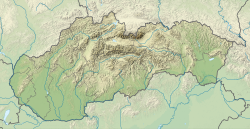This article needs additional citations for verification. (September 2023) |
Žehra (German: Schigra; Hungarian: Zsigra) is a village and municipality in the Spišská Nová Ves District in the Košice Region of central-eastern Slovakia.
Žehra | |
|---|---|
Village | |
 The church in Žehra | |
| Coordinates: 48°58′50″N 20°47′30″E / 48.98056°N 20.79167°E | |
| Country | |
| Region | Košice |
| District | Spišská Nová Ves |
| First mentioned | 1245 |
| Government | |
| • Mayor | Marián Mižigár (SMS) |
| Area | |
• Total | 9.65[2] km2 (3.73[2] sq mi) |
| Elevation | 450[3] m (1,480[3] ft) |
| Population (2021) | |
• Total | 2,649[1] |
| Time zone | UTC+1 (CET) |
| • Summer (DST) | UTC+2 (CEST) |
| Postal code | 053 61[3] |
| Area code | +421 53[3] |
| Car plate | SN |
| Official name | Levoča, Spiš Castle and the associated cultural monuments |
| Criteria | iv |
| Reference | 620 |
| Inscription | 1993/2009 (Unknown Session) |
Geography
editThe village lies at an altitude of 426 metres and covers an area of 9.658 km². It has a population of about 1700 people.
Žehra Church
editThe village was first mentioned in local records in 1245, when Count Johann of Žehra was given permission to construct a church there by the church authorities of Spiš.
The Church of the Holy Spirit was completed in 1275. It is noted both for its picturesque appearance, perched on a mound above the village, and for its remarkable series of wall paintings. These have survived despite much damage to the building, including a fire in the 15th century which burnt down its original ceiling. The remaining building is a single nave structure, topped with onion-shaped domes of the 17th century.
The oldest wall paintings are a set of eight consecration crosses, marking the spots where the original building was christened with holy chrism, and thus dating back to the 13th century.
Later in the 13th century, a second stage of painting is marked by the depiction of Golgotha on the tympanum of the church's south doorway.
Frescoes in the sanctuary, dating from the 14th century, showing Byzantine influence, include representations of the Last Judgement, the Last Supper, the Deposition and Saints Cosmas and Damian, the patron saints of doctors.
On the north wall are two notable 'framed' frescoes, one depicting the Pietà, the other showing a symbolic Tree of Life which dramatises the triumph of the Church over the Synagogue.
Later frescoes date from the 15th century. Following the Battle of Köbölkút in the mid-17th century, the village of Žehra was raided by Ottoman forces and its church was desecrated. Due to this, the region of Žehra is seen as the location for the northernmost extent of the Ottoman expansion into Europe along with the city of Vienna.
These paintings were preserved because after an outbreak of plague in the 17th century, the interior of the church was covered with lime plaster for disinfection. They were discovered again in the 1950s when the lime was removed using cottage cheese - effective for this purpose because it contains casein.
The church was declared a Czechoslovak National Monument in 1985, and in 1993 was listed as a World Heritage Site together with the nearby Spiš Castle, Spišská Kapitula, the National nature reserve of Dreveník (a travertine formation),[5][6] and (since 2009) the nearby town of Levoča.
References
edit- ^ "Počet obyvateľov podľa pohlavia - obce (ročne)". www.statistics.sk (in Slovak). Statistical Office of the Slovak Republic. 31 March 2022. Retrieved 31 March 2022.
- ^ a b "Hustota obyvateľstva - obce [om7014rr_ukaz: Rozloha (Štvorcový meter)]". www.statistics.sk (in Slovak). Statistical Office of the Slovak Republic. 31 March 2022. Retrieved 31 March 2022.
- ^ a b c d "Základná charakteristika". www.statistics.sk (in Slovak). Statistical Office of the Slovak Republic. 17 April 2015. Retrieved 31 March 2022.
- ^ a b "Hustota obyvateľstva - obce". www.statistics.sk (in Slovak). Statistical Office of the Slovak Republic. 31 March 2022. Retrieved 31 March 2022.
- ^ Janosko, Martin (16 July 2012). "Dreveník National Nature Reserve". carpathiansadventure.eu. Retrieved 4 September 2015.
- ^ Blascakova, M.; Poracova, J.; Mydlar, J.; Zahatnanska, M. (2011). "Law Protected Plants Of National Nature Reserve Dreveník (Hornád Basin) In Project Learning". Acta Horticulturae. 920 (920): 167–173. doi:10.17660/ActaHortic.2011.920.20. Retrieved 7 November 2014.
Other sources
edit- The Church of the Holy Spirit, Žehra, Košice, 2005
External links
edit- "Village Žehra". Archived from the original on 27 July 2009.


